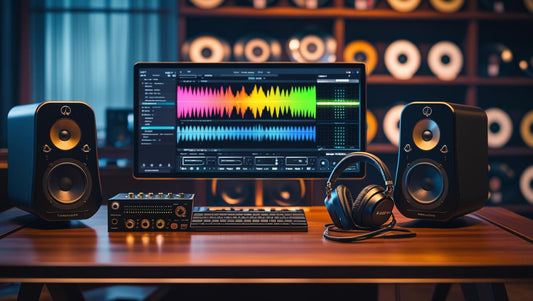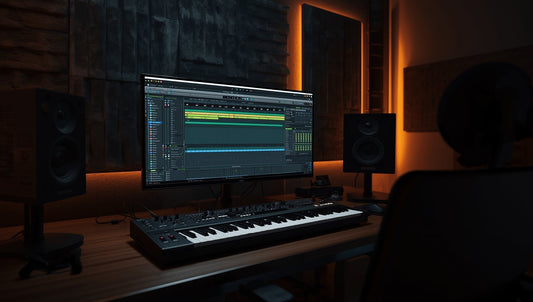Trap Beat Essentials: Step-by-Step Insights for Aspiring Music Producers

Diving into the world of trap music production is like stepping into a realm where creativity meets culture with a bang. From the unmistakable thump of 808s to the intricate dance of hi-hats, making trap beats is both an art and a science that beckons aspiring producers to unleash their unique sound. This beginner's guide on how to make trap beats will walk you through the process step-by-step, highlighting essential techniques and must-know tips to craft that perfect banger. We'll explore the moody melodies, vocal chops, and driving rhythms that define the genre, while spotlighting legendary producers who paved the way. So, tune your ears and fire up your DAW—let's transform your musical vision into a trap masterpiece.
Core Ingredients of Trap Beats
Trap beats are built on a foundation of distinctive elements that give the genre its unmistakable sound. Let's break down these core components and explore how they come together to create the trap magic.
The Power of 808s
The 808 is the heartbeat of trap music, serving as both a thunderous kick drum and a rumbling sub-bass. This versatile sound can be manipulated to create a wide range of emotions and energy levels in your beats.
To harness the power of 808s, start by selecting a high-quality sample. Tune it to match your track's key, ensuring it harmonizes with your melodies. Experiment with pitch slides and glides to add movement and character.
Distortion can beef up your 808s, giving them extra presence in the mix. However, use it sparingly to maintain clarity. Remember, the 808 should be felt as much as heard, so pay attention to how it sits in your mix.
For more advanced techniques, check out this comprehensive guide on crafting 808s.
Hi-Hat Rhythms and Rolls
Hi-hats are the secret sauce that gives trap beats their infectious groove. The intricate patterns and rolls create a sense of urgency and drive the rhythm forward.
Start with a basic pattern, then layer in variations. Use pitch shifting to add melodic elements to your hi-hat lines. Experiment with different velocities to create dynamic patterns that ebb and flow.
Triplet rolls are a hallmark of trap music. Practice programming these rapid-fire sequences to add excitement to your beats. Don't be afraid to get creative with panning and stereo width to create a sense of space.
Remember, less can be more. Sometimes a simple, well-placed hi-hat pattern can be more effective than a complex one. Trust your ears and focus on what serves the overall groove of your track.
Crafting Moody Melodies
Trap melodies often lean towards the dark and atmospheric, creating an emotional backdrop for vocals or serving as the main hook of an instrumental.
Focus on minor keys and simple, repetitive patterns. Two-bar or three-bar loops can create an hypnotic effect. Layer in atmospheric pads or abstract textures to add depth and dimension to your melodies.
Don't shy away from unconventional sound sources. Many trap producers use vocal chops, obscure samples, or even everyday sounds as melodic elements. The key is to create a vibe that complements the hard-hitting rhythm section.
For inspiration on crafting unique trap melodies, check out this thread on essential trap production tips.
Influential Trap Producers
The evolution of trap music has been shaped by visionary producers who pushed the boundaries of the genre. Let's explore some of the key figures who have left their mark on trap production.
Pioneers of the Genre

The early architects of trap laid the groundwork for the genre we know today. Producers like Shawty Redd and DJ Toomp were instrumental in developing the trap sound in the early 2000s.
Shawty Redd's brass horn driven sound(Think HBCU Marching Bands) approach and hard-hitting 808s became a blueprint for future producers. His work with Young Jeezy helped define the trap sound and aesthetic.
DJ Toomp, known for his collaborations with T.I., brought a more polished, cinematic quality to trap production. His use of orchestral elements and complex arrangements expanded the sonic palette of the genre.

These pioneers set the stage for trap's eventual mainstream breakthrough, influencing countless producers along the way.
Modern Innovators
Today's trap landscape is dominated by a new generation of producers who have taken the genre to new heights. Names like Metro Boomin, Southside, and Sonny Digital have become synonymous with modern trap production.
Metro Boomin's signature dark, atmospheric sound has made him one of the most sought-after producers in hip-hop. His ability to craft memorable melodies and hard-hitting beats has resulted in numerous chart-topping hits.
Southside, known for his work with 808 Mafia, has pushed the boundaries of trap with his aggressive, high-energy productions. His innovative use of samples and unconventional sound design has inspired many up-and-coming producers.

Zaytoven's piano-driven beats and distinctive drum programming have become a staple of Atlanta trap. His melodic approach has influenced a whole generation of producers, blending traditional musicianship with modern production techniques.
Step-by-Step Trap Beat Guide
Creating a trap beat from scratch can seem daunting, but with the right approach, you can craft a banger in no time. Let's break down the process into manageable steps.
Setting the Tempo and Drums
The foundation of any trap beat lies in its tempo and drum pattern. Here's how to get started:
-
Choose your tempo. Trap typically ranges from 130-150 BPM, with 140 BPM being a sweet spot for beginners.
-
Start with your kick drum. Program a simple pattern that emphasizes the downbeats.
-
Add your snare or clap, usually on the 2nd and 4th beats of each bar.
-
Layer in hi-hats. Begin with a basic eighth-note pattern, then add variations and rolls.
Remember, simplicity is key. A clean, hard-hitting drum pattern will set the stage for the rest of your beat.
For more detailed guidance on crafting your drum patterns, check out this comprehensive trap production tutorial.
Building the 808 and Melodies
With your drums in place, it's time to add the low-end punch and melodic elements:
-
Choose an 808 sample that complements your kick drum.
-
Program your 808 pattern, focusing on the root notes of your chord progression.
-
Experiment with pitch slides and note length to create movement.
-
Craft a simple, catchy melody using a synth or sampled instrument.
-
Layer in atmospheric pads or textures to add depth to your beat.
Don't overcomplicate your melodies. In trap, less is often more. Focus on creating a vibe that supports the rhythm section.
Final Touches and Transitions
The finishing touches can elevate your beat from good to great:
-
Add transitional elements like risers, impacts, or vocal chops to create excitement between sections.
-
Use automation to create movement in your mix. Try panning hi-hats or modulating filter cutoffs.
-
Implement drops and breakdowns to add dynamic contrast to your beat.
-
Leave space for vocals. Remember, your beat should complement, not overpower, the artist.
Finally, focus on your mix. Ensure each element sits well in the frequency spectrum and contributes to the overall groove of your track.
"The key to a great trap beat is balance. You want it to hit hard, but still have room for the artist to shine." - Metro Boomin
Remember, practice makes perfect. Keep experimenting, studying your favorite producers, and developing your unique sound. With time and dedication, you'll be crafting trap bangers in no time.
No comments








0 comments